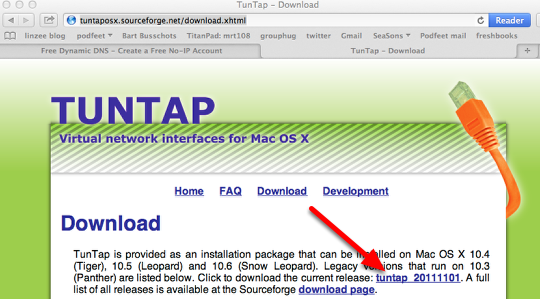Tun Tap Driver Mac Os X
This problem can happen if the remnants of a previously installed VPN service are still present on your Mac. Make sure that you completely uninstall and remove other VPN software if still installed.
If the problem persists, manually remove the TUN or TAP kexts (device drivers) that are no longer needed.
Manually remove the TUN or TAP kexts of other VPN services
On the Apple menu bar, click Go > Utilities.
In the Utilities window, double-click Terminal.
In the Terminal window, type the following and hit enter:
sudo kextstat grep -i tun
Type your administrator password and hit enter.
In the Terminal window, kext details are displayed. Make a note of the TUN or TAP kexts found on your Mac.
For example, in the following details, 'foo.tun' is the kext name.
115 0 0xffffff7f81968000 0x6000 0x6000 foo.tun (1.0) <7 5 4 1>
Following are a few common TAP or TUN kexts:
net.tunnelblick.tun and net.tunnelblick.tap
foo.tun and foo.tap
com.cisco.cscotun
com.viscosityvpn.Viscosity.tun and com.viscosityvpn.Viscosity.tap
com.pogoplug.xcetun
In the Terminal window, type the following and hit enter:
sudo kextunload -b foo.tun
Replace 'foo.tun' in the above command with the kext found on your Mac in line 4.
Exit Terminal, and restart your Mac.

- Tunnelblick is an open source GUI for OpenVPN on the Mac OS X platform. It gives you easy control over OpenVPN clients and server connections. The app comes complete to use straight out of the box, with all the necessary binaries and drivers, including OpenVPN, easy-rsa, and tun/tap drivers.
- 仮想ネットワークデバイスを mac os x で試してみたくて調べてた。tun/tap は共に仮想ネットワークデバイスの仕組みで、名前自体は知ってたけれど違いがよく分かってなかったので改めて調べてみると、.
14 thoughts on “ Correct Way to set up OpenVPN Client on Mac OS X ” Karel Minarik November 30, 2007 at 10:03 am. Hi, thank you very much! Works absolutely brilliant 🙂 (Maybe just add reminder to chmod +x the.sh script, so people like me don’t forget to do that:)).
Unfortunately, the Cisco AnyConnect client for Mac conflicts with Pow. And by 'conflicts', I mean it causes a grey-screen-of-death kernel panic anytime you connect to the VPN and Pow is installed.
As an alternative, there is OpenConnect, a command-line client for Cisco's AnyConnect SSL VPN.
Here's how to get it set up on Mac OS X:
OpenConnect can be installed via homebrew:
Install the Mac OS X TUN/TAP driver
(Optional) Running openconnect requires sudo, presumably because it affects resolution of DNS. So, I added password-less sudo ability for the openconnect command.
And added this line:
(Optional) When connecting to your SSL VPN, openconnect may complain about a 'self-signed certificate' being in the chain and force you to explicitly accept it every time. The self-signed cert is actually the root certficate and (hopefully) is one with implicit trust (i.e. trusted by browsers), so we can safely trust it by specifying the CA file after exporting it from KeyChain:
Determine the name your root certificate (i.e. visit your SSL VPN in Chrome, click the green lock, click 'Certificate Information')
Open the Keychain Access App
Search the 'System Roots' keychain to find your root certificate and select it
File>Export Items...the certificate as a.pemfile somewhere on your hard drive (I put it in~/.ssh/<certificate name>.pemConnect!
The only thing you should be prompted for is your VPN password. I added the command to my aliases file.
To disconnect, just Ctrl-c in the window where you started the VPN connection.
Note
Windows Tun Tap Driver
I had an incident after an unclean VPN exit where later the VPN hostname could not be found. I guess the DNS resolver was messed up. I was forced to reboot to fix it so I could reconnect to the VPN.